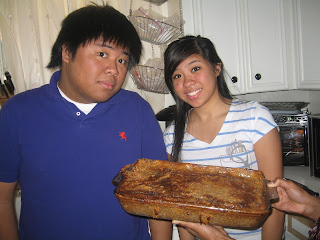Food and Oral History: Rice Cake (Biko)
 |
| My cousins Paul and Diana. Diana made the rice cake. |
My brothers and sisters and I were sad because we thought that this recipe was lost when our grandmother died. We take these things for granted, that a recipe is a recipe and with the internet you can find almost anything. Maybe to some extent this is true. If it is, then why were we unable to duplicate my grandmother's rice cake? Was there some secret ingredient she threw in there that we could not distill in our own taste buds? After grandmother died, we used to be excited every time we saw the rice cake at a Filipino party. To our dismay, the recipe of others did not quite have that something that grandma's had.
For the Merienda party, I called my uncle to see if he would cook my grandma's rice cake. He responded with an "I will try," then click on the phone. It was literally a twenty word conversation, if even. I was not sure what to expect. Imagine my delight when I discovered that my uncle had the recipe for the rice cake and that my cousin would attempt to cook the recipe! Not only would we be able to revitalize the lost recipe, but my cousin was going to learn how to cook the cake and this in itself was a sign of passing down something to the next generation, which is "a beautiful thang."
When the cake was presented at the party, my aunt mentioned that in the process, my cousin thought she had burnt it. My aunt was not sure, but she looked to me imploringly and asked, "I think it is supposed to look like that, right?" I nodded and replied that I thought it looked just like grandma's cake. Rather than look at the crispy, brown top as burnt, we are supposed to look at it as a caramelization of the brown sugar, which can be tasty because it adds to the texture.
 |
| Grandma's handwritten Biko recipe |
So here is the recipe for Biko (rice cake) as written by Grandma Cording:
Biko
6 cups sweet rice add 6 cups water - boil till done.
Boil 1 1/2 box of brown sugar to 2 cans of coconut milk till it will form thick syrup.
Mix the cook rice to the syrup of coconut milk and brown sugar till absorb. Transfer to a baking pan and top it with condense milk and bake till the condense milk turns brown.
It is amazing that this recipe has only three ingredients. It is the simplicity of it that makes it so good. I like to cut the rice cake up in little squares so people can just nibble in small bits. This is helpful to do at a party if all your guests claim to be cutting down on carbs. It only takes one person eating the cake to give that stamp of approval before the rest of the cake gets devoured. If you have leftovers, it is okay because this cake tastes even better the next day after it has been chilled. Drink with warm tea.
After eating the cake for the first time since my grandmother died, I was still a little disappointed. In my heavy-hearted realization, I acknowledge that she was the missing ingredient we had longed for. For a brief moment while enjoying the Biko, she was with me. I quietly smiled and sipped my tea.



Comments
Post a Comment